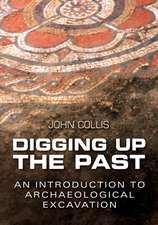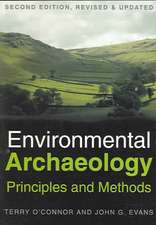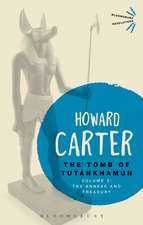Beastly Questions: Animal Answers to Archaeological Issues
Autor Naomi Sykesen Limba Engleză Paperback – 23 sep 2015
| Toate formatele și edițiile | Preț | Express |
|---|---|---|
| Paperback (1) | 231.16 lei 6-8 săpt. | |
| Bloomsbury Publishing – 23 sep 2015 | 231.16 lei 6-8 săpt. | |
| Hardback (1) | 773.45 lei 6-8 săpt. | |
| Bloomsbury Publishing – 27 aug 2014 | 773.45 lei 6-8 săpt. |
Preț: 231.16 lei
Nou
Puncte Express: 347
Preț estimativ în valută:
44.23€ • 46.31$ • 36.60£
44.23€ • 46.31$ • 36.60£
Carte tipărită la comandă
Livrare economică 05-19 aprilie
Preluare comenzi: 021 569.72.76
Specificații
ISBN-13: 9781474260695
ISBN-10: 1474260691
Pagini: 240
Ilustrații: 34 bw illus
Dimensiuni: 156 x 234 x 15 mm
Greutate: 0.36 kg
Editura: Bloomsbury Publishing
Colecția Bloomsbury Academic
Locul publicării:London, United Kingdom
ISBN-10: 1474260691
Pagini: 240
Ilustrații: 34 bw illus
Dimensiuni: 156 x 234 x 15 mm
Greutate: 0.36 kg
Editura: Bloomsbury Publishing
Colecția Bloomsbury Academic
Locul publicării:London, United Kingdom
Caracteristici
The
importance
of
zooarchaeology
is
increasingly
acknowledged
and
considered
in
archaeological
study
and
research
Notă biografică
Naomi
Sykesis
Senior
Lecturer
in
Zooarchaeology
at
the
Department
of
Archaeology,
University
of
Nottingham,
UK.
Cuprins
PrefaceChapter
1:
Animals
and
People:
Mirrors
and
WindowsChapter
2:
Animal
'Revolutions'Chapter
3:
Wild
Animals
and
Human
SocietiesChapter
4:
Animal
Diaspora
and
Culture
ChangeChapter
5:
Ideas
of
LandscapeChapter
6:
The
Chapter
about
RitualChapter
7:
Friends,
Confidants
and
LoversChapter
8:
MeatReferences
Recenzii
A
typically
sideways,
very
personal,
look
at
the
study
of
animal
remains
from
archaeological
deposits,
offering
a
new
approach
centred
upon
understanding
the
full,
complex
relations
between
people
and
the
animals
around
them.
Students
will
appreciate
this
as
a
source
of
information
and
ideas,
academics
will
welcome
a
gust
of
fresh
air
through
a
dusty
subject,
and
the
general
reader
will
enjoy
a
lively,
often
irreverent,
book
on
a
fascinating
topic.
This volume provides an important and provocative contribution to the zooarchaeological literature. Naomi Sykes demonstrates that zooarchaeology can do much more than simply provide appendices to archaeological site reports. She shows that faunal remains can answer a range of interesting questions about human-animal relationships in the past.
Naomi Sykes begins Beastly Questions thus, 'Zooarchaeology has begun to bore me.' That is not really true. What troubles her greatly is the sterility of a certain kind of zoöarchaeology which identifies, measures, orders and quantifies animal remains but fails to interrogate them as traces of the co-constituted social and cultural relations between humans and other animals in the past. Beastly Questions is a feisty, imaginative, academically thorough and extremely readable exploration of the potentials and possibilities of a new social zooarchaeology. From mere bones Sykes fleshes out the animals and reconnects them to human worlds. Bored? Not at all! This is a powerful reanimation.
Anybody who cares for animals will enjoy this book just as much as specialists involved in the study of the past. It will be a great companion volume for scholars and students in archaeology and history as well as those who would like to understand why we need animals around us not only for meat and milk, but also for company and as metaphors for life and living even in the most modernized urban society. The 770 scholarly works listed in the book's reference list lend weight to the author's educated arguments on these exciting questions.
This volume provides an important and provocative contribution to the zooarchaeological literature. Naomi Sykes demonstrates that zooarchaeology can do much more than simply provide appendices to archaeological site reports. She shows that faunal remains can answer a range of interesting questions about human-animal relationships in the past.
Naomi Sykes begins Beastly Questions thus, 'Zooarchaeology has begun to bore me.' That is not really true. What troubles her greatly is the sterility of a certain kind of zoöarchaeology which identifies, measures, orders and quantifies animal remains but fails to interrogate them as traces of the co-constituted social and cultural relations between humans and other animals in the past. Beastly Questions is a feisty, imaginative, academically thorough and extremely readable exploration of the potentials and possibilities of a new social zooarchaeology. From mere bones Sykes fleshes out the animals and reconnects them to human worlds. Bored? Not at all! This is a powerful reanimation.
Anybody who cares for animals will enjoy this book just as much as specialists involved in the study of the past. It will be a great companion volume for scholars and students in archaeology and history as well as those who would like to understand why we need animals around us not only for meat and milk, but also for company and as metaphors for life and living even in the most modernized urban society. The 770 scholarly works listed in the book's reference list lend weight to the author's educated arguments on these exciting questions.














